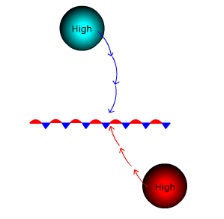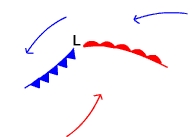Wave cyclonesThe variable nature of weather in the midlatitudes is in part due to the presence of midlatitude or extratropical cyclones. Appropriately called "wave cyclones", these systems take the form of an ocean wave when fully developed. Wave cyclones can grow to vast proportions, nearly 1000 miles (1600 km) wide. These vast areas of low pressure are born along the polar front where cold polar air from the north collides with warm tropical air to the south. In so doing, huge spiraling storms move across the surface guided by the polar front jet stream. Initial Stage - CyclogenesisWave cyclones form where surface convergence predominates. Cyclones often develop in the region of the Aleutian and Icelandic sub-polar low pressure cells. Wave cyclones also develop and intensify on the east slope of the Rocky Mountains, the Gulf Coast and east coasts of North America and Asia.
Especially during the spring and summer in the midlatitudes of North America, high pressure to the north pushes cold polar air southward from Canada. To the south, maritime tropical air streams northward toward the polar air (Figure 8.9).The polar front is depicted by the symbols for a stationary front (the alternating red semi-circle and blue triangles). At the location where the opposing streams of air meet, cyclonic shear is created from opposing air streams sliding by each other causing the air to spin. You can demonstrate what happens as a result of cyclonic shear by placing a pencil between your hands. Push your right hand away from you (warm southerly flow) and draw your left hand towards you (cold, northerly flow). (Go ahead and try this to see if I'm right.) Examine what happens to the pencil. If you followed directions the pencil should be rotating in a counterclockwise fashion. Click here for more information about the initial stage of cyclone development.
Mature Stage
Once the air collides and cyclonic circulation commences, warm air from the south invades where cold air was once located north of the polar front (Figure 8.10). A warm front develops where warm air replaces the cold air. The position of a warm front on a weather map is depicted (in red) with a line showing the boundary between the air masses and semi-circles indicating the direction the front is moving. To the west of the center of the developing system, cold air is sliding south replacing warm air at the surface. A cold front (blue triangles) develops where cold air replaces the warm air. Soon the developing system takes on the characteristic wave form, hence their name "wave cyclone". The lowest pressure is found at the center or apex of the wave. Figure 8.11 depicts the profile view of the open wave along a cross section just to the south of the system center. The less dense warmer air slides up and over the colder more dense air. Surface friction imposed by the ground slows the advance of the front compared to its position aloft yielding a gentle slope to the front.
Figure 8.11 Profile View through a midlatitude cyclone |



